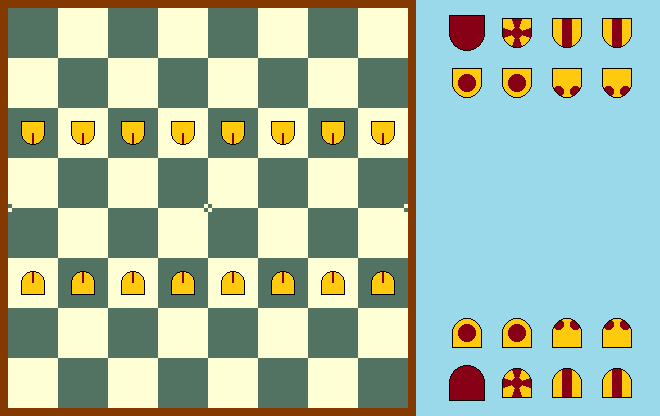iChess
Inspired by Shogi and Pal Benko's Pre-Chess, iChess is an attempt to improve Chess in four different ways:
- eliminating the irregularities in the rules, such as castling as en passant,
- reducing the importance of memorized opening and ending moves,
- reducing the percentage of drawn games,
- increasing the number of possible moves in each turn, making the game harder to solve by computers.
To achieve these goals, iChess combines the elements of Chess and Shogi, and allows the players to select the initial position of the pieces.
Setup
Like Chess, iChess is played on a checkered 8x8 board. Each player begins with one King, one Queen, two Rooks, two Bishops, two Knights, and eight Pawns. Only the Pawns are initially on the board.

Initial position of the game
The game begins with the deployment phase. The first player picks a piece other than the King and drop it onto the board, and then the second player does the same. The players continue in this way until all the pieces are placed. The Kings are dropped last (on the eighth move), after which the pieces may start moving.
Pieces
The iChess pieces are similar to Shogi pieces in shape, but use abstract motifs that are designed to be culturally neutral.
 |
The Pawn moves and captures one square forward like the Shogi pawn. It can promote to a Ferz upon reaching the last four ranks of the board. Promotion is optional unless the Pawn reaches the last rank. |
 |
The Ferz is a promoted Pawn. It moves one square diagonally like the Shatranj Ferz. |
 |
The Knight moves like the Chess Knight. |
 |
The Bishop moves like the Chess Bishop. |
 |
The Rook moves like the Chess Rook. |
 |
The Queen moves like the Chess Queen. |
 |
The King moves like the Chess King, minus castling. It may not move into check. A player loses when the King is checkmated. |
Rules
After the initial deployment phase (described above), the rules of iChess are mostly the same as Shogi, but there are some differences.
The iChess board is divided into two parts. A player's drop zone consists of the the four ranks closest to the player. Drops, including the initial drops in the deployment phase, are restricted within the drop zone. The other half of the board (the opponent's drop zone) is the player's promotion zone. Pawns may promote only when they reach the promotion zone.
In each turn, a player may either move a piece on the board or drop a captured piece onto a vacant square. As in Shogi, a Pawn may not be dropped into a file that already contains another friendly Pawn, but unlike Shogi, the Pawn drop may deliver a checkmate. When a Ferz is captured, it is demoted back to a Pawn.
Play
If you have Zillions of Games installed on your computer, you can play this game. Click here to download iChess.If you want to play using a physical set, you can use a standard 8x8 chessboard with Shogi pieces. The suggested piece mapping is:
| Shogi | iChess |
|---|---|
| Pawn (Tokin) | Pawn (Ferz) |
| Knight | Knight |
| Lance | Rook |
| Silver General | Bishop |
| Gold General | Queen |
| King | King |
Sample Game
The notation below follows the standard algebraic notation. The equal sign (=) indicates a drop or a promotion. For example, R=a1 means Rook is dropped on a1, and Pc5=F means Pawn moves to c5 and promotes to Ferz.
- R=a1 R=h8
- B=f4 R=f8
- R=g1 Q=a8
- Q=f2 B=d5
- B=e4 N=g8
- N=g4 N=g5
- N=c4 B=c5
- K=h1 K=a7 end of deployment phase
- BxNg5 PxBg5
- BxBd5 PxBd5
- Nh2 Ne7
- N=e4 Rhg8
- B=f4 Pd4
- PxPd4 BxPd4
- P=d3 Pc5
- PxBd4 PxNc4
- PxPc4 Nf5
- Pc5=F N=h7
- FxPb6+ KxFb6
- Rad1 Rd8
- Qc2 Rc8
- Qd3 B=e7
- Ra1 Qb7
- NxPf6 NxPg3+
- RxNg3 BxNf6
- B=e4 Qd7
- BxNh7 QxPd4
- QxQd4+ BxQd4
- Q=b4+ N=b5
- BxRg8 RxBg8
- N=a4+ Ka7
- QxNb5 BxRa1
- Qb6+ Ka8
- QxPa6+ R=a7
- Nb6#

Final position of the game
Contact
Please contact Pangus Ho at hzb_pangus at hotmail.com for any comments or suggestions.
 This 'user submitted' page is a collaboration between the posting user and the Chess Variant Pages. Registered contributors to the Chess Variant Pages have the ability to post their own works, subject to review and editing by the Chess Variant Pages Editorial Staff.
This 'user submitted' page is a collaboration between the posting user and the Chess Variant Pages. Registered contributors to the Chess Variant Pages have the ability to post their own works, subject to review and editing by the Chess Variant Pages Editorial Staff.
By Pangus Ho.
Web page created: 2014-06-19. Web page last updated: 2014-06-19
